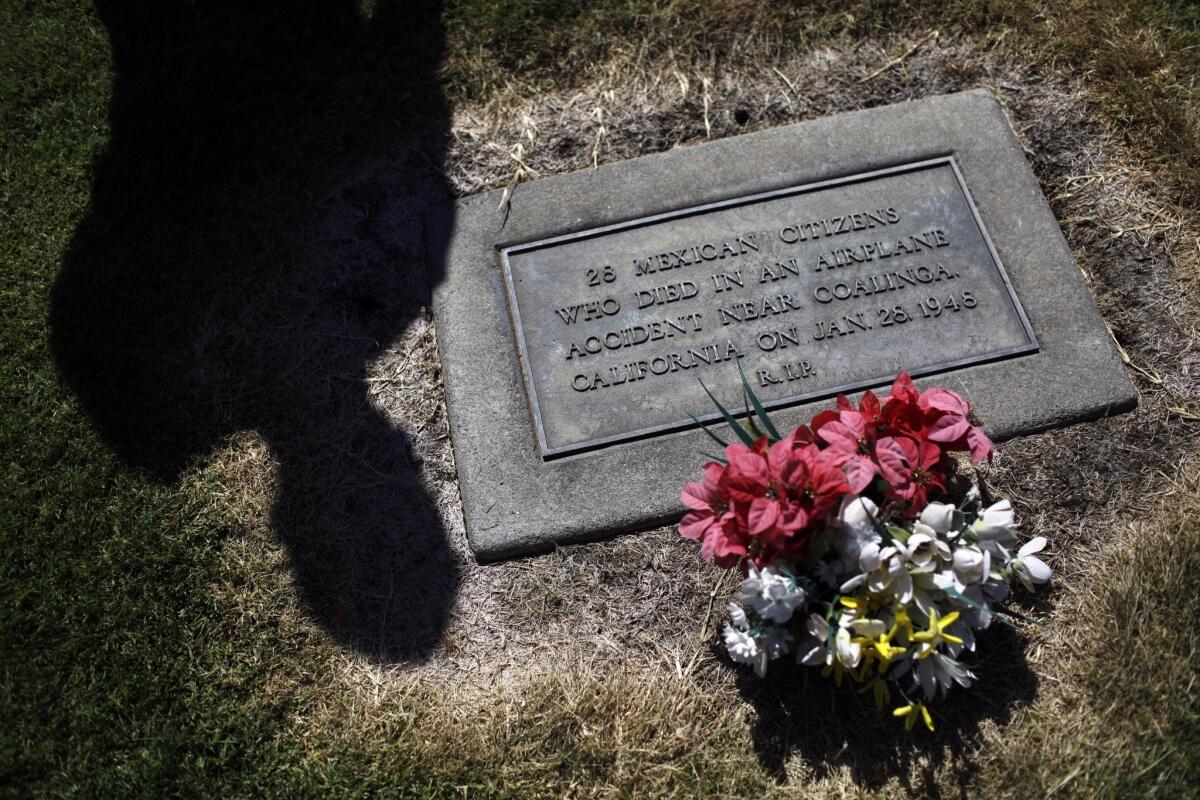Setting Times stories to music: From Glasvegas to Woody Guthrie

When was the last time you wrote a letter? Not a postcard. Not a greeting card, either. I’m talking one written on a sheet of paper -- or, better yet, on several sheets of paper.
Or how about this: When was the last time you got a letter? If the answer is “never,” let me tell you: The little “ting” of an incoming email just can’t compare to the feeling of opening your mailbox and seeing a handwritten letter with your name on it.
One of this week’s Great Reads, about a young immigrant who became pen pals with the most powerful person in the Senate, renewed my resolve to start writing letters again. And it reminded me of a musical connection to the days when I actually wrote them.
My oldest friend used to be roommates with the twins who went on to become the Scottish band the Proclaimers. We wrote regularly back then, and I’ve always hoped that the envelope postmarked U.S.A. gave them the spark for the marvelous “Letter From America.” (Reid twins, if you’re reading this and it isn’t the case, don’t disabuse me of my fantasy.)
Anyway, in these roundups of the week gone by, I’d like to offer the first paragraphs of each Great Read (or, as they’re known in print, Column One) -- maybe they’ll buy your eye and you can settle in for a good weekend read. And you’ll also get the songs that inspired me while editing the stories, or reading them later if my fellow editor Millie Quan has shepherded the story through. A story-song combo!
Algae bloom delights some beachgoers in China, as cleanup begins
As far as Li Lejun is concerned, there’s one easy way to make a July beach vacation even better than expected: Add seaweed. Hundreds upon hundreds of tons of it.
Buried up to his thighs in sand, his back covered in what looked like strands of chartreuse cotton candy, the 7-year-old Beijing boy was having the time of his life Sunday at No. 1 Bathing Beach in this city 350 miles north of Shanghai.
Ten paces to his right, men in swim briefs were using pitchforks to fling mounds of algae into a yellow front-end loader. In the other direction, a backhoe was scooping great piles of it into dump trucks. On Saturday, Lejun and his 69-year-old grandpa had helped gather globs of it from the sea, plopping it into plastic bags with other volunteers.
“It’s really fun to play with!” Lejun said. “It’s very soft and fun to touch.”
For at least the sixth year running, a giant algae bloom has engulfed the waters around this city like a bright green shag carpet mutating uncontrollably. This year’s seaweed mass has been measured at about 11,500 square miles — more than twice the area of Los Angeles County. Onshore winds help bring the strands ashore overnight, with some beaches buried under 16 inches of the floss-like flora, known to scientists as Ulva prolifera.
#storysongs combo: “Deep Shag,” by Luscious Jackson. (Times staff writer Julie Makinen had memorably described the algae as being like a green shag carpet). She also suggested this pairing: “Green Grass and High Tides” by the Outlaws.
Child victims of sex crimes find safety at Stuart House
It didn’t take long to settle the fate of Edgar Humberto Somoza.
Few people were present that morning in the small 15th-floor courtroom. Somoza chose not to speak. The judge said he hoped “two sweet little girls” would not be permanently scarred.
Then he sentenced Somoza to the maximum 65 years to life for sexually assaulting his 7- and 8-year-old stepdaughters.
On a bench in the back, one of Somoza’s adult daughters burst into ragged sobs.
For others in the room, though, this was a moment of triumph.
LAPD Det. Supervisor Moses Castillo had worked the case from Day One. At the start, he said, there were big challenges. There was no DNA evidence on the children. No confession. All the prosecutor had was the girls’ story.
Success was possible, Castillo said, because of the work done in a pale-pink, two-story building in Santa Monica.
The mission at Stuart House is to fight for child victims — and make them feel safe. An enormous plush dog sprawls in welcome just inside the entry, next to a playroom full of toys and games.
#storysongs combo: “Geraldine,” by Glasvegas. A tough band sings a tender song about a social worker being “the angel on your shoulder.”
Names emerge from shadows of 1948 crash
Jaime Ramirez stood in front of an oak tree, jagged and black from a plane crashing into it all those years ago. He removed his white cowboy hat, closed his eyes and whispered, “Abuelo, Tio, estoy aqui.” (“Grandfather, Uncle, I am here.”)
Nearby, Tim Z. Hernandez, who had feared this moment might never happen, leaned down and sprinkled tobacco and sage. When the writer first came to this hushed place, looking into a 65-year-old mystery, he had felt he was intruding. Each time he returned, he always left a small offering. He could hear the Woody Guthrie song “Plane Wreck at Los Gatos” playing in his head:
The sky plane caught fire over Los Gatos Canyon,
A fireball of lightning, and shook all our hills,
Who are all those friends, all scattered like dry leaves?
On Jan. 28, 1948, a plane chartered by U.S. Immigration Services left Oakland carrying 32 people, including 28 Mexicans. Many were part of the bracero program and had finished their government-sponsored work contracts. A ride home was part of the deal. Others had entered the country illegally.
Over farms and ranches on the edge of the Diablo Range, 20 miles west of Coalinga, the World War II surplus DC-3 trailed black smoke. An engine exploded. A wing broke off, floating left and right. More than 100 witnesses watched bodies and luggage thrown from the fireball. There were no survivors.
This marker at Holy Cross cemetery in Fresno will be replaced by a monument with the names of all the Mexican citizens who perished in the 1948 crash.
News accounts named only the pilot, first officer, stewardess — who was also the pilot’s wife — and an immigration officer. The others were listed simply as “deportees.”
#storysongs combo: “Plane Wreck at Los Gatos (Deportee),” by Woody Guthrie. This version is by his songwriting son, Arlo, and the incomparable harmonizer Emmylou Harris. (Serendipitously, the story ran on Arlo’s birthday.)
Fighting cancer to see son grow up
Her son said “Mommy” for the first time after Nina Polvanich Louie came home from chemotherapy.
Donny started preschool the morning Nina first met her oncologist. When she returned from another appointment, the 2-year-old looked her in the eye and said something he never had before: “I love you.”
For a parent, every milestone a child passes is an achievement. For Nina, 32, each time Donny does something new is also a reminder of how little time she may have left with him.
Nina has an advanced stage of blood cancer and is hoping to find a bone marrow donor within a month. Doctors say she has about a 1-in-20,000 chance of finding a match.
The other day, Nina saw a young boy waiting with his father and mother in the hospital where she gets treatment. The child was playing a game, putting his hands on his father’s and trying to pull them away before his dad could tap them. He laughed whenever his father playfully slapped his hands.
As she watched the family, Nina quietly started to cry.
“Donny can’t do that yet,” she said, “and I wondered if I would ever have a moment like that with him.”
#storysongs combo: “Never Let Me Go,” by Florence + the Machine. This is the unplugged version, and her voice is pretty spectacular live.
In the U.S. illegally, she inspires a senator
When Astrid Silva wrote her first letters to Harry Reid, the Senate majority leader, she never really expected that he, or anyone else, would read the folded notes she slipped to the Nevada senator as he campaigned in the state she called home.
But in a way, it didn’t matter. The words, written in her girlish hand, spilled out in a cathartic flow, a release of all the sadness and disappointment — and lingering hope — that had piled up inside the 21-year-old as she came to understand the netherworld she was caught in.
Her life was defined by one crucial moment, when she stepped onto a tire raft, wearing a frilly white dress and patent leather shoes, to be pulled across the Rio Grande with her mother. She was 4, carrying her Ken doll.
Now, as an adult, she had no legal status. Unable to work legally, she baby-sat for a living. Once tops in her class, she feared that her family would be deported if she applied to a university. Without a driver’s license, she relied on friends or the bus to avoid the scorching Las Vegas streets.
The senator did not know what to make of the earnest woman who handed him that first letter in summer 2009. He recalled stuffing the note in a pocket and thinking it was “just a nuisance or something.”
“And then I read it,” he said.
And so began one of the more unusual relationships in Washington, a correspondence between a young woman in the country illegally and the most powerful man in the Senate.
#storysongs combo: “Box Full of Letters,” by Wilco. “Can’t find the time to write my mind the way I want it to read.”
If you have ideas for story-song pairings of your own, tweet the title and artist to @karihow or @LATimesColumn1 with the hashtag #storysongs.
Twitter: @karihow
More to Read
Sign up for Essential California
The most important California stories and recommendations in your inbox every morning.
You may occasionally receive promotional content from the Los Angeles Times.










